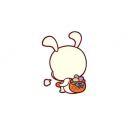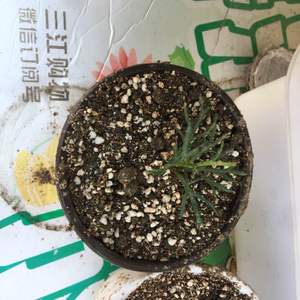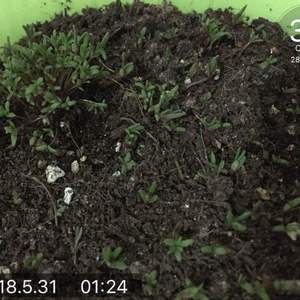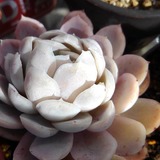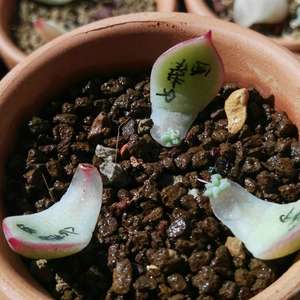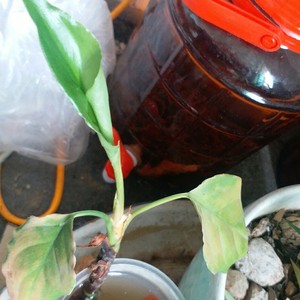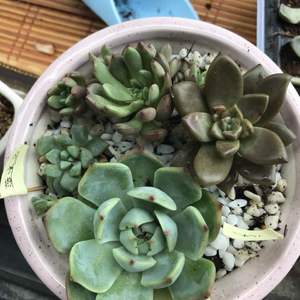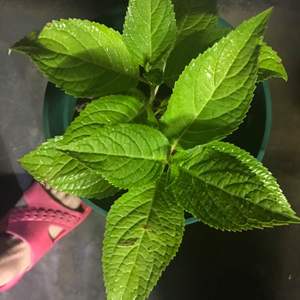文章
Miss Chen
2018年05月29日

Description: This herbaceous perennial plant is about ½–1¼' tall. It consists of a single erect stem that has 3 spreading leaves at its apex. A mature plant produces a single sessile flower above the leaves, while an immature plant produces only leaves. The stem is light green, medium green, or yellowish green; it is terete, glabrous, and fairly stout. The leaves are up to 6" long and 3½" across; they are ovate in shape and smooth along their margins, tapering into distinct petioles. The upper leaf surface is mottled with patches of light and dark green, although sometimes it is solid green. The lower leaf surface is pale green. Both surfaces are glabrous. In addition to parallel primary veins, the leaves also have diagonal secondary veins that crisscross between the primary veins. Each flower consists of 3 yellow petals, 3 green sepals, 6 yellow stamens, and a green ovary with 3 stigmata.
The petals are 1–1¼" long, rhombic-elliptic in shape, and erect, curving inward toward their tips. The sepals are ¾-1" long, glabrous, and triangular-lanceolate in shape; they hang downward from the base of the flower. The stamens are about ½" long, curving inward toward their tips; the large anthers of the stamens are narrowly oblongoid in shape and longer than the filaments. The blooming period occurs from mid- to late spring, lasting about 3-4 weeks. There is no noticeable floral scent. Individual flowers are fairly long-lasting. Afterwards, the flowers are replaced by 3-celled fruits (technically berries) that contain many small seeds. These fruits are a little less than ½" in length (about 10 mm.), rhombic-ovoid in shape, 6-angled, and greenish. The seeds are dark brown and partially white from their food appendages. The root system consists of a thickened erect rootstock, secondary fibrous roots, and rhizomes, from which clonal offsets are occasionally produced.

Cultivation: This plant prefers dappled sunlight to medium shade, mesic levels of moisture, and rich loamy soil with decaying leaf litter. Like other Trillium spp. (Trilliums), this species is slow to develop because of the short period of active growth during the spring. The foliage persists until about the middle of summer.
Range & Habitat: The native Shay's Trillium is quite rare in Illinois. According to official records, it has been observed in only Jackson County. However, the webmaster encountered it in Champaign County a few years ago, and there has been scattered sitings of Shay's Trillium in northern Illinois (see Distribution Map). Habitats include mesic deciduous woodlands where the original flora has remained little disturbed by modern development.

Faunal Associations: The pollinators of the yellow flowers are unknown. Caterpillars of the polyphagous moths Clepsis melaleucana (Black-patched Clepsis) and Euplexia benesimilis (American Angle Shades) feed on trilliums (Covell, 1984/2005). Because of their food appendages, the seeds are distributed to new locations by ants. White-tailed Deer are very fond of the foliage and flowers of trilliums as a source of food. Their seeds can pass through the digestive tract of these animals and germinate in new locations (Vellend et al., 2003). However, too many deer can cause populations of trilliums to decline because of excessive browsing.
Photographic Location: A mesic deciduous woodland at Busey Woods in Urbana, Illinois, and a woodlands in Ogle County, Illinois. The photograph of the Shay's Trillium with mottled leaves was taken by Lisa Culp (Copyright © 2013).

Comments: Shay's Trillium (Trillium recurvatum shayii) is a rare form of the common Prairie Trillium (Trillium recurvatum). The typical form of this species has maroon flowers and black anthers. Another uncommon form of the Prairie Trillium that occurs within the state, Trillium recurvatum lutescens, has yellow flowers like Shay's Trillium, however its anthers are black or purple. In contrast, Shay's Trillium has yellow anthers. All three forms of this trillium usually have leaves that are mottled in different shades of green, however, plants with solid green leaves also occur. Regardless of its form, the Prairie Trillium differs from other trilliums in Illinois by the following set of characteristics: 1) its flowers are sessile, 2) its leaves have petioles, 3) its sepals hang downward, and 4) its petals are yellow or maroon. Other trilliums have flowers on short stalks, or their leaves are sessile, or their sepals are spreading to ascending, or their petals are white.
The petals are 1–1¼" long, rhombic-elliptic in shape, and erect, curving inward toward their tips. The sepals are ¾-1" long, glabrous, and triangular-lanceolate in shape; they hang downward from the base of the flower. The stamens are about ½" long, curving inward toward their tips; the large anthers of the stamens are narrowly oblongoid in shape and longer than the filaments. The blooming period occurs from mid- to late spring, lasting about 3-4 weeks. There is no noticeable floral scent. Individual flowers are fairly long-lasting. Afterwards, the flowers are replaced by 3-celled fruits (technically berries) that contain many small seeds. These fruits are a little less than ½" in length (about 10 mm.), rhombic-ovoid in shape, 6-angled, and greenish. The seeds are dark brown and partially white from their food appendages. The root system consists of a thickened erect rootstock, secondary fibrous roots, and rhizomes, from which clonal offsets are occasionally produced.

Cultivation: This plant prefers dappled sunlight to medium shade, mesic levels of moisture, and rich loamy soil with decaying leaf litter. Like other Trillium spp. (Trilliums), this species is slow to develop because of the short period of active growth during the spring. The foliage persists until about the middle of summer.
Range & Habitat: The native Shay's Trillium is quite rare in Illinois. According to official records, it has been observed in only Jackson County. However, the webmaster encountered it in Champaign County a few years ago, and there has been scattered sitings of Shay's Trillium in northern Illinois (see Distribution Map). Habitats include mesic deciduous woodlands where the original flora has remained little disturbed by modern development.

Faunal Associations: The pollinators of the yellow flowers are unknown. Caterpillars of the polyphagous moths Clepsis melaleucana (Black-patched Clepsis) and Euplexia benesimilis (American Angle Shades) feed on trilliums (Covell, 1984/2005). Because of their food appendages, the seeds are distributed to new locations by ants. White-tailed Deer are very fond of the foliage and flowers of trilliums as a source of food. Their seeds can pass through the digestive tract of these animals and germinate in new locations (Vellend et al., 2003). However, too many deer can cause populations of trilliums to decline because of excessive browsing.
Photographic Location: A mesic deciduous woodland at Busey Woods in Urbana, Illinois, and a woodlands in Ogle County, Illinois. The photograph of the Shay's Trillium with mottled leaves was taken by Lisa Culp (Copyright © 2013).

Comments: Shay's Trillium (Trillium recurvatum shayii) is a rare form of the common Prairie Trillium (Trillium recurvatum). The typical form of this species has maroon flowers and black anthers. Another uncommon form of the Prairie Trillium that occurs within the state, Trillium recurvatum lutescens, has yellow flowers like Shay's Trillium, however its anthers are black or purple. In contrast, Shay's Trillium has yellow anthers. All three forms of this trillium usually have leaves that are mottled in different shades of green, however, plants with solid green leaves also occur. Regardless of its form, the Prairie Trillium differs from other trilliums in Illinois by the following set of characteristics: 1) its flowers are sessile, 2) its leaves have petioles, 3) its sepals hang downward, and 4) its petals are yellow or maroon. Other trilliums have flowers on short stalks, or their leaves are sessile, or their sepals are spreading to ascending, or their petals are white.
0
0
文章
Miss Chen
2018年05月29日

Description: This herbaceous perennial plant is ½-1¼' tall and unbranched. The erect central stem is light green to reddish purple, terete, rather stout, and glabrous. At the apex of this stem, there are 3 spreading leaves surrounding a single sessile flower. Immature plants, however, produce only leaves without the flower. The leaves are 3-6" long and 1½-3½" across; they are ovate in shape and smooth along their margins, tapering into distinct petioles. The upper leaf surface is medium green and heavily mottled with patches of light green and dark green; it is glabrous. The lower leaf surface is pale green and unmottled; it is also glabrous. On rare occasions, some plants will have leaves with solid green upper surfaces. Leaf venation is parallel with occasional interconnecting secondary veins.
The flower has 3 maroon petals, 3 green sepals, 6 stamens with long black anthers, and an ovary with 3 stigmata. The petals are 1–1¼" long and rhombic-elliptic in shape; they curve inward toward their tips. The sepals are ¾–1" long, lanceolate-triangular in shape, and smooth along their often purplish margins; they hang downward from the base of the flower. The stamens are about ½" long, curving inward toward the other stamens. The blooming period is mid- to late spring, lasting about 3-4 weeks. Individual flowers are relatively long-lived. There is no noticeable floral scent. Afterwards, each flower is replaced by a single fruit (technically a berry). These fruits are a little less than ½" (10 mm.) long, rhomboid-ovoid in shape, 6-angled, and pale green to purplish green. Each fruit contains several small seeds; they are dark brown with white food appendages. The main rootstock is thickened and elongated, with numerous feeder roots. Rhizomes are also produced, causing this plant to form clonal colonies.

Cultivation: The preference is medium shade to dappled sunlight, moist to dry-mesic conditions, and soil containing loam or clay-loam. The foliage is rarely bothered by pests or disease. Trilliums are slow to develop because of the short period of active growth during the spring, and up to 10 years may be required before a plant reaches flowering size in the wild.
Range & Habitat: The native Prairie Trillium is a common plant that occurs in every county of Illinois (see Distribution Map). It is found primarily in rich woodlands, open woodlands, and savannas, where deciduous trees are dominant (including oak-hickory woodlands and maple-dominated woodlands). Sometimes this species survives degradation of woodland habitats, and it can be found along fence rows with woody vegetation, overgrown areas near railroads, and miscellaneous waste areas with partial or light shade.

Faunal Associations: The maroon flowers of the Prairie Trillium may attract carrion beetles and flesh flies, although little is known about the insect pollinators of this trillium (Trillium sp.) because floral visitors are rare. Only pollen is available as a floral reward. The caterpillars of two polyphagous moths, Clepsis melaleucana (Black-patched Clepsis) and Euplexia benesimilis (American Angle Shades) feed on trilliums (Covell, 1984/2005). The seeds of these plants are often distributed by ants because of their food appendages. Among mammalian herbivores, White-tailed Deer are especially known to eat the flowers and foliage of trilliums. There is also some evidence that the seeds of trilliums can pass through their digestive tracts and remain viable. Therefore, White-tailed Deer may help to distribute the seeds across long distances (Vellend et al., 2003). Where White-tailed Deer are too abundant, however, they may destroy local populations of these plants. It is possible that the mottled pattern of the foliage of the Prairie Trillium is an adaptation to deer predation as this type of pattern may help to camoflage the plant with the surrounding forest floor.

Photographic Location: A mesic woodland at Busey Woods in Urbana, Illinois, and an upland savanna in McLean County, Illinois.
Comments: The common name is misleading because the Prairie Trillium occurs in woodlands like other trilliums (Trillium spp.), rather than prairies. However, it is especially common in Illinois and the surrounding states where prairies occur. This trillium species is relatively easy to identify for the following reasons: 1) its sepals hang downward from the flower, whereas in other Trillium spp. the sepals are usually spreading to ascending; 2) its flowers are sessile against the central stem and leaves, whereas the flowers of some trilliums (e.g., Trillium erectum) are held above the foliage on short stalks; and 3) the leaves taper gradually at their bases into short petioles, whereas the leaves of some trilliums are sessile and quite rounded at their bases. There are different forms of the Prairie Trillium that have yellow or maroon flowers, yellow or black anthers, and mottled or solid green leaves. The form described here, Trillium recurvatum recurvatum, is by far the most common.
The flower has 3 maroon petals, 3 green sepals, 6 stamens with long black anthers, and an ovary with 3 stigmata. The petals are 1–1¼" long and rhombic-elliptic in shape; they curve inward toward their tips. The sepals are ¾–1" long, lanceolate-triangular in shape, and smooth along their often purplish margins; they hang downward from the base of the flower. The stamens are about ½" long, curving inward toward the other stamens. The blooming period is mid- to late spring, lasting about 3-4 weeks. Individual flowers are relatively long-lived. There is no noticeable floral scent. Afterwards, each flower is replaced by a single fruit (technically a berry). These fruits are a little less than ½" (10 mm.) long, rhomboid-ovoid in shape, 6-angled, and pale green to purplish green. Each fruit contains several small seeds; they are dark brown with white food appendages. The main rootstock is thickened and elongated, with numerous feeder roots. Rhizomes are also produced, causing this plant to form clonal colonies.

Cultivation: The preference is medium shade to dappled sunlight, moist to dry-mesic conditions, and soil containing loam or clay-loam. The foliage is rarely bothered by pests or disease. Trilliums are slow to develop because of the short period of active growth during the spring, and up to 10 years may be required before a plant reaches flowering size in the wild.
Range & Habitat: The native Prairie Trillium is a common plant that occurs in every county of Illinois (see Distribution Map). It is found primarily in rich woodlands, open woodlands, and savannas, where deciduous trees are dominant (including oak-hickory woodlands and maple-dominated woodlands). Sometimes this species survives degradation of woodland habitats, and it can be found along fence rows with woody vegetation, overgrown areas near railroads, and miscellaneous waste areas with partial or light shade.

Faunal Associations: The maroon flowers of the Prairie Trillium may attract carrion beetles and flesh flies, although little is known about the insect pollinators of this trillium (Trillium sp.) because floral visitors are rare. Only pollen is available as a floral reward. The caterpillars of two polyphagous moths, Clepsis melaleucana (Black-patched Clepsis) and Euplexia benesimilis (American Angle Shades) feed on trilliums (Covell, 1984/2005). The seeds of these plants are often distributed by ants because of their food appendages. Among mammalian herbivores, White-tailed Deer are especially known to eat the flowers and foliage of trilliums. There is also some evidence that the seeds of trilliums can pass through their digestive tracts and remain viable. Therefore, White-tailed Deer may help to distribute the seeds across long distances (Vellend et al., 2003). Where White-tailed Deer are too abundant, however, they may destroy local populations of these plants. It is possible that the mottled pattern of the foliage of the Prairie Trillium is an adaptation to deer predation as this type of pattern may help to camoflage the plant with the surrounding forest floor.

Photographic Location: A mesic woodland at Busey Woods in Urbana, Illinois, and an upland savanna in McLean County, Illinois.
Comments: The common name is misleading because the Prairie Trillium occurs in woodlands like other trilliums (Trillium spp.), rather than prairies. However, it is especially common in Illinois and the surrounding states where prairies occur. This trillium species is relatively easy to identify for the following reasons: 1) its sepals hang downward from the flower, whereas in other Trillium spp. the sepals are usually spreading to ascending; 2) its flowers are sessile against the central stem and leaves, whereas the flowers of some trilliums (e.g., Trillium erectum) are held above the foliage on short stalks; and 3) the leaves taper gradually at their bases into short petioles, whereas the leaves of some trilliums are sessile and quite rounded at their bases. There are different forms of the Prairie Trillium that have yellow or maroon flowers, yellow or black anthers, and mottled or solid green leaves. The form described here, Trillium recurvatum recurvatum, is by far the most common.
0
0




